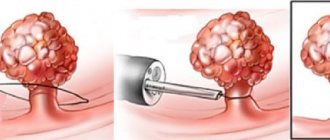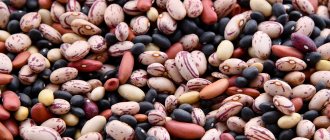Simethicone is an effective medicine that helps children and adults get rid of flatulence, colic and stomach discomfort. It is absolutely harmless, has few contraindications and can be used from birth.
Simethicone has antifoaming and carminative properties. It is a translucent gray viscous liquid. Contains 4-7% finely dispersed silicon dioxide. It does not dissolve in ethyl alcohol, water, oil, fat. Does not change its properties under the influence of acid, is not sensitive to microorganisms. The drug does not disrupt metabolic processes and the absorption mechanism of microelements and vitamins. Considered safe for long-term use.
Composition per capsule:
| Active substance: Simethicone* (Dimethicone (polydimethylsiloxane)) Silicon dioxide | 40.0 mg 38.05 mg | 80.0 mg 76.10 mg |
| Excipients: shell: | ||
| Gelatin | 24.670 mg | 25.140 mg |
| Glycerol | 11,360 mg | 11,580 mg |
| Purified water | 3.140 mg | 3,200 mg |
| Sodium benzoate | 0.047 mg | 0.048 mg |
| Quinoline yellow dye E-104 | 0.027 mg | 0.028 mg |
| Sunset yellow dye E-110 | 0.007 mg | 0.007 mg |
*simethicone is a mixture of dimethicone (polydimethylsiloxane) and silicon dioxide in a ratio of 95:5;
Composition and release form
Simethicone is available in various forms:
- Capsules, 40 mg;
- Emulsion 100 mg/ml and 40 mg/ml in vials;
- Suspension, 40 mg/ml and 66.6 mg/;
- Oral drops, 40 mg/ml;
- Chewable tablets, 80, 125 mg.
The main active ingredient is simethicone, an organic compound of silicon dioxide and dimethylsiloxane. Its analogues, recommended for newborns, contain purified water, flavorings, and sweeteners. Simethicone with fennel contains fennel essential oil.
Description
Spherical or almost spherical soft gelatin capsules from yellow to orange in color with a seam and a smooth surface. The contents of the capsules are a colorless, viscous, opalescent liquid. Pharmacotherapeutic group: carminative.
ATX code:
A03AX13
Pharmacological properties
Pharmacodynamics
Simeotik® is a drug that reduces the amount of gas in the intestines. The active ingredient, simethicone, has surface activity and the ability to reduce surface tension at the liquid/gas interface. In this case, the gas bubbles merge and the foam is destroyed, as a result of which the released gas is able to be absorbed or excreted naturally under the influence of intestinal peristalsis. The use of Simeotik® in preparation for diagnostic studies prevents the occurrence of image defects caused by gas bubbles.
Pharmacokinetics
Simethicone is chemically inert, after oral administration it is not absorbed from the gastrointestinal tract (GIT) and acts only in its lumen. Does not affect enzymes and microorganisms present in the gastrointestinal tract. Output unchanged.
Simethicone
Simethicone
(lat.
simethicone
) - carminative, defoaming drug.
Chemical compound:
mixture of poly(dimethylsiloxane) and silica. Structural formula (CH3)3Si-[OSi(CH3)2]n-CH3+SiO2. Simethicone is an activated dimethicone (dimethicone is a silicon oil from dimethylsiloxane polymers) and consists of 93-96% dimethicone and 4-7% finely divided silicon dioxide and is superior to dimethicone in effectiveness.
Simethicone is the international nonproprietary name (INN) of the drug. According to the pharmacological index, it is classified as a carminative. According to ATC, simethicone was recently reclassified and currently it belongs to the section “Drugs for the treatment of functional gastrointestinal disorders” and has the code “A03AX13 Silicones” (previously it had the code “A02DA01 Dimethicone”).
Simethicone has surface-active properties, exhibiting the ability of an antifoam: it reduces the surface tension of gas bubbles (defoaming activity) in the gastrointestinal tract, leading to their rupture; The gases released during the disintegration of bubbles are absorbed by the intestinal walls or eliminated due to peristalsis, reducing the gas content in the intestines. When contrasting the gastrointestinal tract, it ensures uniform irrigation of the mucous membranes with a contrast agent, prevents rupture of the contrast film, and prevents interference and overlap of images. Chemically inert, not absorbed from the gastrointestinal tract, excreted unchanged.
Simethicone is used during esophagogastroduodeno- and colonoscopy, ensuring the “cleanliness” of the mucous membrane, which significantly increases the likelihood of detecting minimal local changes, allows you to quickly and thoroughly examine all sections, perform targeted biopsies from suspicious areas and other manipulations, which ultimately increases the possibility of early diagnostics of pathological changes and, first of all, early cancer. Simethicone does not irritate the mucous membrane of the gastrointestinal tract, does not change the endoscopic picture, and does not affect the motor-evacuation function of the stomach and intestines. In addition, simethicone is safe for the patient and does not have a negative (damaging) effect on expensive endoscopic equipment (Samedov B.Kh.).
Simethicone is an important component of antacid medications. Antacids with simethicone effectively relieve abdominal pain and symptoms of gastric dyspepsia, due to the good effect of simethicone on flatulence, which in the vast majority of cases stops on the 3rd – 7th day (Minushkin O.N., Elizavetina G.A.).
Foods rich in carbohydrates contribute to the formation of gases in the stomach and intestines. Undigested protein substrates accumulate in the intestinal lumen, forming foam - a dispersed system consisting of gas and liquid bubbles, which obeys the laws of surface tension. A pronounced disruption of the processes of digestion and absorption of food components contributes to greater formation of gases and the creation of conditions for the formation of stable foam. Covering the surface of the intestinal mucosa with a thin layer, foam complicates parietal digestion, reduces the activity of enzymes, and reduces the reabsorption of gases. To eliminate these violations, adsorbents and defoamers are used, in particular, simethicone. Simethicone reduces the severity of gas formation in the intestines, reduces abdominal pain caused by excessive formation of gases in the digestive tract, aerophagia, digestive disorders, absorption and excretion, and contributes to a significant improvement in the general condition of flatulence. Simethicone is indicated for patients with pathologies of the proximal small intestine, liver diseases, non-ulcer dyspepsia syndrome, in the postoperative period (Kirik D.L., Polyakova I.F.).
Indications for use:
Increased gas formation and accumulation of gases in the gastrointestinal tract (flatulence, dyspepsia, aerophagia, Roemheld syndrome, gas formation in the postoperative period); preparation for radiographic, ultrasound or sonographic examinations of the abdominal and pelvic organs, preparation for gastroduodenoscopy, as an additive to a suspension of contrast agents to obtain a double contrast image (in the form of an emulsion); as an antifoam agent for poisoning with surfactants.
Professional medical articles concerning the use of simethicone in the treatment of gastrointestinal diseases:
- Minushkin O.N., Elizavetina G.A. Antacids in modern therapy of acid-dependent diseases // Consilium Medicum. – 2003. – T.5. – No. 7.
- Samedov B.Kh. Recommendations for the use of espumizan during endoscopic examinations of the gastrointestinal tract and transendoscopic manipulations // North-West Bulletin of Endoscopy. – 2003.
- Kovaleva K.A. Enzyme preparations in gastroenterological practice // RMZh. Diseases of the digestive system. – 2008. – volume 10. – No. 2. – p. 76–79.
restrictions on the use of simethicone by pregnant and breastfeeding mothers
. The FDA has not determined the fetal risk category for pregnant women taking simethicone.
Brands of medicines
,
having the only active substance simethicone: Antiflat Lannacher, Bobotik, Disflatil, Sab simplex, Simikol, Espumisan, Espumisan 40, Espumisan L, as well as the Ukrainian drug Kolikid. Instructions from the manufacturer
Medana Pharma, JSC, Poland, medicines with the active ingredient simethicone, (pdf): “Instructions for medical use of the drug Bobotik”, drops for oral administration, 66.66 mg/ml, as amended on January 27, 2010.
Simethicone in combinations with other active substances:
- loperamide + simethicone, brand name Imodium plus
- algeldrat + magnesium hydroxide + simethicone, trademarks Almagel Neo and Liquid antacid "York" with simethicone
- magaldrate + simethicone, brand name Antareit
- alverine citrate + simethicone, brand name Meteospasmil
- cinitapride + simethicone, brand name Rogastril Plus (approved for use in Argentina)
- fungal amylase + papain + simethicone + nicotinamide + activated carbon (Enzimtal, Ukraine)
- simethicone + dicycloferine hydrochloride (Gazospazam, Ukraine)
Other antacids
that contain simethicone: Gestide, Relzer.
Simethicone has contraindications, side effects and application features; consultation with a specialist is necessary.
Back to section
Indications for use
- Excessive formation and accumulation of gases in the gastrointestinal tract (flatulence, Roemheld syndrome, aerophagia, increased gas formation in the postoperative period);
- Preparation for diagnostic studies of the abdominal and pelvic organs (ultrasound, X-ray studies, etc.);
- Symptoms of excess gas formation caused by functional dyspepsia;
- Acute poisoning from detergents containing foaming agents (as an antifoam agent).
How the drug works
The cause of anxiety in an infant is most often associated with colic and increased gas formation in the intestines. These phenomena are caused by an imperfect enzyme system and a microflora that has just begun to form. Due to a lack of enzymes, a large amount of undigested food enters the intestines, where fermentation processes are activated with the release of gases.
Simethicone reduces the content of gases in the intestines, releasing them from mucous vesicles. The released gas is absorbed by the intestinal walls or, thanks to its peristalsis, removed from the body without creating discomfort. The drug prevents the formation of new bubbles.
When fennel is included in the medicine, it reduces spasms, enhances the production of gastric juice and intestinal secretions, promotes digestion, and eases colic. Simethicone, thus, reduces gas formation, reduces pain arising from the accumulation of gases, and improves the overall well-being of the child.
The drug also protects the surface of the ventricular mucosa from the effects of acids. It is believed to inhibit the growth of Helicobacter pylori bacteria. The drug is not absorbed or metabolized and is excreted unchanged from the body. No addiction to this drug has been identified.
Directions for use and doses
For complaints related to excessive gas formation:
Adults and children over 6 years old: 2 capsules of 40 mg or 1 capsule of 80 mg 3-5 times a day, with a small amount of liquid, after each meal and before bedtime.
The duration of treatment depends on the presence of symptoms of increased gas formation. If necessary, Simeotik® can be used for a long period of time.
Preparation for diagnostic tests:
2 capsules 40 mg or 1 capsule 80 mg 3 times a day the day before the study, 2 capsules 40 mg or 1 capsule 80 mg in the morning on the day of the study, without drinking water.
As an antifoaming agent for poisoning with detergents containing foaming agents: a single dose for adults is 10-20 capsules 40 mg or 5-10 capsules 80 mg, for children over 6 years old 3-10 capsules 40 mg or 2-5 capsules 80 mg per one dose; dosage depends on the severity of intoxication.
If there is no improvement after treatment, or symptoms worsen, or new symptoms appear, you should consult your doctor.
Use the drug only according to the indications, method of administration and in the doses indicated in the instructions.
Contraindications and side effects
An absolute contraindication for simethicone is individual intolerance to the components in the product. In addition, taking the drug for intestinal obstruction is prohibited. The drug is not prescribed until the age of 6 years.
There were no negative side reactions of the body when taking the drug. The exception is allergic reactions that may occur due to intolerance to the drug. Overdose of the drug has not been confirmed in practice. If you experience any unpleasant body reactions after taking it, you should stop taking the drug and consult a doctor.
Analogs
Direct analogues of the drug that can be used for newborns are medications with simethicone, such as:
- Oral suspension Sab Simplex;
- Emulsion Espumisan L and drops for oral use – Espumisan baby;
- Suspension Antiflat Lannacher;
- Disflatitis drops;
- Drops Bobotik;
- Drops, suspension and emulsion Simikol;
- Suspension Infacol.
These medications contain Simethicone and additional components - flavorings and sweeteners.
Drugs that have a similar effect include:
- Plantex,
- Pepphys,
- Gascon Drop,
- Carminative collection.
However, the active substance in them is different.
Price
Currently, most pharmacies only sell Simethicone with fennel in capsules, 25 pieces per package. The price in Moscow pharmacies is 200-250 rubles. Its use is contraindicated for children under 6 years of age.
Medicines containing Simethicone are sold in other forms under other brand names: Espumisan, Sab Simplex, Bobotik. Prices for Sub Simplex in suspension vary from 280 to 300 rubles. Bobotik drops cost from 265 rubles. The price of Espumisan L emulsion starts from 345 rubles, Espumin baby drops – from 403 rubles.
Instructions and dosage
Instructions for use describe average dosages for different forms of release of the drug. Before giving Simethicone to an infant, you should consult your doctor. He will prescribe the dosage, frequency and duration of administration.
- In case of severe gas formation, infants from 1 month to 1 year are given 8 drops 4 times a day every 6 hours. Treatment is stopped after symptoms decrease.
- The suspension is included in each feeding in a volume of 10-15 drops.
- In case of intoxication with surfactants, 20-25 ml of suspension is prescribed.
The medicine is taken during or after meals. Shake the bottle well before using the suspension. In case of overdose, you must immediately contact your doctor and clarify the next steps.
The drug is stored in a dark, dry place at room temperature. Liquid forms should not be frozen. After opening the bottle, the medicine should be used within a month. After this period, its use is contraindicated.








